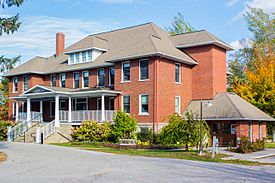Benzonia, Michigan facts for kids
Quick facts for kids
Benzonia, Michigan
|
|
|---|---|
|
Village
|
|

The Mills Community House in Benzonia
|
|

Location within Benzie County
|
|
| Country | |
| State | |
| County | Benzie |
| Township | Benzonia |
| Area | |
| • Total | 1.13 sq mi (2.93 km2) |
| • Land | 1.13 sq mi (2.93 km2) |
| • Water | 0.00 sq mi (0.00 km2) |
| Elevation | 817 ft (249 m) |
| Population
(2020)
|
|
| • Total | 551 |
| • Density | 487.18/sq mi (188.09/km2) |
| Time zone | UTC-5 (Eastern (EST)) |
| • Summer (DST) | UTC-4 (EDT) |
| ZIP code(s) |
49616
|
| Area code(s) | 231 |
| FIPS code | 26-07580 |
| GNIS feature ID | 2398099 |
| Website | https://www.villagebenzonia.com/ |
Benzonia (/bɛnˈzoʊniə/ BEN-zoh-NEE-ə) is a village in Benzie County in the U.S. state of Michigan. The population was 551 at the 2020 census, up from 497 at the 2010 census. The village is located within Benzonia Township at the southeast end of Crystal Lake on U.S. Highway 31 at the junction with M-115 west.
Geography
According to the United States Census Bureau, the village has a total area of 1.13 square miles (2.93 km2), all land.
History
Benzonia began in 1858 as an educational Christian colony on the model of Oberlin, Ohio. Its founding was under the leadership of Charles E. Bailey. The village, which was once the county seat, was incorporated in 1891.
In 1863 Grand Traverse College was chartered and began here. It was renamed Benzonia College in 1891. In 1900 the college was changed to a preparatory school named Benzonia Academy. The academy continued to function until 1918 when it was closed. In his book Waiting for the Morning Train, historian Bruce Catton captured local history and documented his perspective of growing up in Benzonia as his father was an instructor at the academy.
Demographics
| Historical population | |||
|---|---|---|---|
| Census | Pop. | %± | |
| 1900 | 484 | — | |
| 1910 | 563 | 16.3% | |
| 1920 | 543 | −3.6% | |
| 1930 | 623 | 14.7% | |
| 1940 | 340 | −45.4% | |
| 1950 | 407 | 19.7% | |
| 1960 | 407 | 0.0% | |
| 1970 | 412 | 1.2% | |
| 1980 | 466 | 13.1% | |
| 1990 | 449 | −3.6% | |
| 2000 | 519 | 15.6% | |
| 2010 | 497 | −4.2% | |
| 2020 | 551 | 10.9% | |
| U.S. Decennial Census | |||
2010 census
As of the census of 2010, there were 497 people, 209 households, and 125 families living in the village. The population density was 439.8 inhabitants per square mile (169.8/km2). There were 275 housing units at an average density of 243.4 per square mile (94.0/km2). The racial makeup of the village was 93.2% White, 1.2% African American, 0.4% Native American, 2.4% from other races, and 2.8% from two or more races. Hispanic or Latino of any race were 6.2% of the population.
There were 209 households, of which 28.7% had children under the age of 18 living with them, 35.9% were married couples living together, 19.1% had a female householder with no husband present, 4.8% had a male householder with no wife present, and 40.2% were non-families. 34.4% of all households were made up of individuals, and 11.5% had someone living alone who was 65 years of age or older. The average household size was 2.38 and the average family size was 3.04.
The median age in the village was 39.9 years. 25.6% of residents were under the age of 18; 8.3% were between the ages of 18 and 24; 21.2% were from 25 to 44; 26.1% were from 45 to 64; and 18.5% were 65 years of age or older. The gender makeup of the village was 45.1% male and 54.9% female.
Notable people
- Bruce Catton, American Civil War historian
- Jennie W. Erickson, probation officer and school superintendent
- Gwen Frostic, artist, author, Michigan Women's Hall of Fame inductee
- Douglass North, economic historian and nobel laureate
See also
 In Spanish: Benzonia (Míchigan) para niños
In Spanish: Benzonia (Míchigan) para niños


